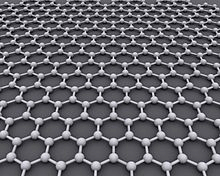Graphene burst into the general consciousness in 2010, when the Nobel Prize committee brought its discovery to the attention of the world with its almost sci-fi inspired properties.

Graphene is a semi-metal form of carbon with many unusual properties. It is the strongest material ever tested, efficiently conducts heat and electricity, can be levitated by neodymium magnets and is nearly transparent.
It is just a single layer of carbon atoms thick, arranged in a “hexagonal lattice”. Because it is so thin, scientists consider graphene two-dimensional rather than three dimensional.
Scientists had theorized about graphene for years, and although it had been unintentionally produced in small quantities for centuries it was not mass produced. It was originally observed via electron microscope in 1962, but it was studied only while supported on a metal surface.
Then in 2004, Andre Geim and Konstantin Novoselov were able to isolate and further study it at the University of Manchester. This work resulted in them winning the Nobel Prize in Physics in 2010 “for groundbreaking experiments regarding the material graphene.”
With the publicity of a Nobel Prize the media erupted with massive hype on the potential uses for Graphene.
Potential Uses for Graphene
According to Graphnea applications in general terms include:
- Biological Engineering
- Optical Electronics
- Ultrafiltration
- Composite Materials
- Photovoltaic Cells
- Energy Storage
In 2013, Gizmondo published an article entitled 9 Incredible Uses for Graphene which included the more fanciful:
- Mega-fast uploads- i.e. a whole terabit in just one second.
- Recharge Your Phone in 5 seconds.
- Clump together radioactive waste, making disposal a breeze.
- Create super-strong lightweight objects like tennis rackets.
- Create super-fine filters able to turn saltwater into freshwater.
- Unbreakable touchscreens.
- High-power graphene supercapacitors making batteries obsolete.
- Allow direct connection of Bionic devices to your neurons.
- Super high-performance headphones.
In addition, because graphene is only a single atom thick, it’s possible to create other materials using its structure. Graphene can be used as “atomic scaffolding” to create other materials by alternating the graphene layers with other compounds,. These newly created compounds could also be superlative materials, just like graphene, but with potentially even more applications.
But that is the “Hype” but it’s been 14 years now since it’s discovery and 8 years since the Nobel Prize so why aren’t we seeing these wonder products?
The first question is: How do you know we’re not?
Graphene Products
Early in the adoption cycle of a product like this, you might expect would be something like:
- High-end watchmaker Richard Mille working in collaboration with the British racing team/supercar manufacturer McLaren has announced a Million Dollar graphene-enhanced watch.
But according to Graphene-info, there are at least “10 graphene-enhanced products already on the market“. These also include other only slightly less high-end products like:
- Ultra-light Bike frames from Dassi Bikes.
- The T-FORCE CARDEA ZERO M.2 PCI-E solid-state drive uses graphene to aid in cooling.
- Nanomedical Diagnostics has a graphene-enhanced NHS Agile biosensor chip that measures biomolecular interactions in real-time.
But surprisingly you can also get products using graphene on Amazon for less than $20.00 :
- The FiiO F3 in-ear monitor earphones currently less than $20 on Amazon.
- Liberty graphene-enhanced fully wireless earphones $99 on Amazon.
- Ultra-light, super strong fishing rods from Century Composites on Amazon.
- Enhanced temperature regulating Ski Jackets from Colmar (originally $999.99 now $499.99 on Amazon)
- Catlike uses graphene to produce ultralight strong cycling helmets, in a line called Mixino, available on Amazon.
So based on the original categories we are already seeing:
- Composite Materials- Bicycles, Helmets, fishing rods, etc.
- Biological Engineering- Biosensors
- Optical Electronics- Watch (related devices earphones, solid-state drives)
We’re also seeing graphene-based inks that can be printed using standard printing presses to create waterproof circuits on fabric enabling the creation of wearable electronics.
It takes time for new technologies to filter down to the general populace but as you can see graphene is already making its way into affordable products and there is much more to come, including materials to enhance space travel (graphene-enhanced rubber), wifi-enabled clothing, RFID tags, etc.
You might also like:
